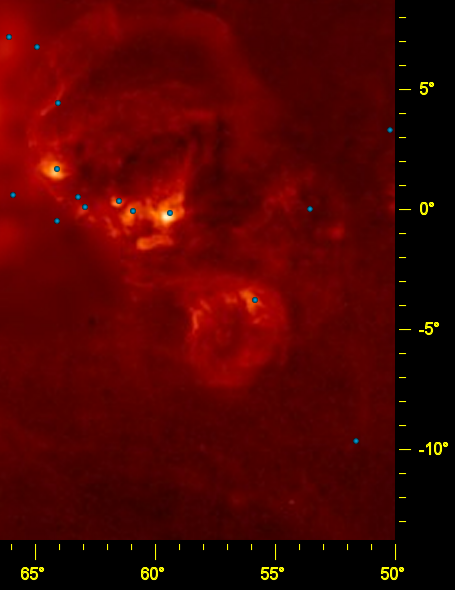
Hover your mouse over each blue dot for the name of the object, or click on the dot for a detail page. This map was created using the all-sky hydrogen-alpha map produced by Douglas Finkbeiner from data collected by the WHAM, VTSS and SHASSA hydrogen-alpha surveys.
This region appears to be dominated by two large lobes. Much of the bright nebulosity at the bottom of the northern lobe is associated with or nearby the supershell GS061+00+51, which seems to surround the
Vulpecula OB1 association at a distance of about 2000 parsecs. Sh 2-86, the radio source W55, surrounds the star cluster NGC 6823 at the heart of Vulpecula OB1. Sh 2-87, Sh 2-88 and Sh 2-89, also seem to be part of or nearby this supershell. Sh 2-90 is also connected to Vulpecula OB1.
Several other objects in the north are unconnected to the supershell.
Sh 2-92, which is ionised by the Wolf-Rayet star WR 127, a binary star with an O9V companion, is much more distant at 3700 parsecs. Sh 2-91, Sh 2-94 and Sh 2-96 are all filaments of the 20 thousand year old supernova remnant SNR 065.2+05.7 only 900 parsecs away.
Sh 2-84 to the south is a distant 5000 parsecs (if indeed this nebula is really associated with what looks to be a fairly large area of emission). One interesting (although completely speculative) explanation for the southern lobe is that it is a ring nebula surrounding the Wolf-Rayet star WR 128, which is located towards the top half of the emission ring.
On the right side of this image near the galactic plane is the combination reflection nebula and HII region Sh 2-82. Far below the galactic plane on the right is the mysterious Sh 2-81 for which there is little information in the scientific literature. Far above the galactic plane is Sh 2-80, the ring nebula surrounding the Wolf Rayet star WR 124, also known as Merrill's star.
On the left side of this image near the galactic plane is Sh 2-93, an HII region ionised by the O9V star [F89b] S93 1 at a distance of 2600 parsecs. It appears to contain the infrared star cluster [BDS2003] 16. On the far left is the planetary nebula NGC 6842 (Sh 2-95) at 1250 parsecs.
